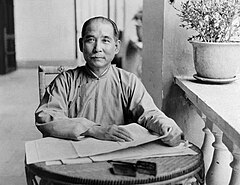This article needs additional citations for verification. (September 2023) |

| Part of a series on |
| Three Principles of the People |
|---|
 |
| Part of a series on |
| Conservatism in China |
|---|
 |
 |
|---|
|
|
Chiangism (Chinese: 蔣介石主義; pinyin: Jiǎng Jièshí Zhǔyì), also known as the Political Philosophy of Chiang Kai-shek (Chinese: 蔣介石的學說; pinyin: Jiǎng Jièshí De Xuéshuō), or Chiang Kai-shek Thought, is the political philosophy of President Generalissimo Chiang Kai-shek, who used it during his rule in China under the Kuomintang on both the mainland and Taiwan. It is a right-wing authoritarian nationalist political ideology which is based on mostly Confucian[1] and Tridemist ideologies, and was used in the New Life Movement in China and the Chinese Cultural Renaissance movement in Taiwan. It is a syncretic mix of many political ideologies, including revolutionary nationalism, Tridemism, socialism (until 1955), militarism, Confucianism, state capitalism, constitutionalism, fascism,[2] authoritarian capitalism (from 1955), and paternalistic conservatism, as well as Chiang's Methodist Christian beliefs.
The extent of the influence of fascism on Chiang's ideology is perceived differently among scholars. Dictatorial power such as martial law is used in a Chiangist government in times of war,[3] civil unrest,[4] and rebellion.[5] Throughout its existence, Chiangism has promoted strong Chinese nationalism throughout the territories controlled by the ROC, as well as promoting Tridemist ideals of a unified Chinese national identity. The Chiangist government mandated Mandarin and emphasized Chinese history and culture in national education curriculums. Mao Zedong and the Chinese Communist Party (CCP) heavily criticized the nationalist practice of the Chiangist KMT government and denounced it as "Han-Centric Chauvinism". The influence of Chiangism was largely diminished in Mainland China by the Campaign to Suppress Counterrevolutionaries of the communists, and most of the influence of Chiangism began to wane at the start of democratization in Taiwan.
- ^ Dirlik, Arif (1975). "The Ideological Foundations of the New Life Movement: A Study in Counterrevolution". The Journal of Asian Studies. 34 (4): 945–980. doi:10.2307/2054509. JSTOR 2054509. S2CID 144316615.
- ^ Eastman, Lloyd (2021). "Fascism in Kuomintang China: The Blue Shirts". The China Quarterly (49). Cambridge University Press: 1–31. JSTOR 652110. Retrieved 2 February 2021.
- ^ "Second Sino-Japanese War | Summary, Combatants, Facts, & Map | Britannica". Britannica.com. Retrieved 2022-05-19.
- ^ Kagan, Richard C. (23 September 1982). "Martial law in Taiwan". Bulletin of Concerned Asian Scholars. 14 (3): 48–54. doi:10.1080/14672715.1982.10412657.
- ^ "Chinese Civil War | Summary, Causes, & Results | Britannica". Britannica.com. Retrieved 2022-05-19.
© MMXXIII Rich X Search. We shall prevail. All rights reserved. Rich X Search

